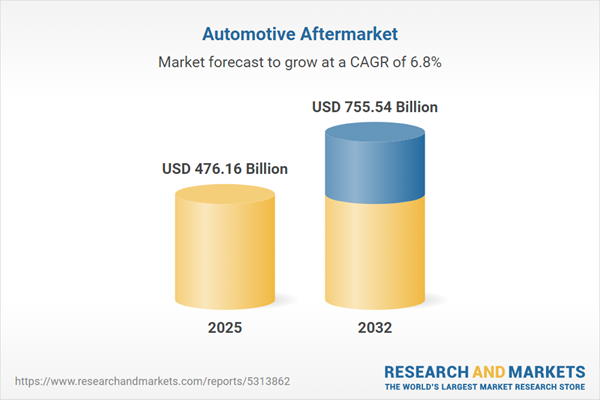Speak directly to the analyst to clarify any post sales queries you may have.
The automotive aftermarket market is evolving rapidly as digital innovation, regulatory shifts, and changing customer preferences reshape how companies compete and deliver value. In this new environment, forward-looking strategies and agile operations are essential for sustained growth and resilience.
Market Snapshot: Automotive Aftermarket Market Outlook
The automotive aftermarket market grew from USD 447.82 billion in 2024 to USD 476.16 billion in 2025, and it is projected to reach USD 755.54 billion by 2032, demonstrating a compound annual growth rate (CAGR) of 6.75%. Growth is shaped by intersecting forces, from accelerating digital enablement and vehicle technology advancements to evolving legislative frameworks and trade dynamics. Companies across the value chain, including OEMs, suppliers, distributors, and service providers, confront new demands for operational agility, transparency, and customer-focused service models.
Scope & Segmentation
This report delivers an in-depth analysis of sub-segments, regional markets, and prominent industry players, supporting decision-makers as they navigate the evolving automotive aftermarket landscape.
- Product Types: Accessories (including exterior, interior, and performance), Body Parts (body panels, mirrors and glass, seats and upholstery, trim and moldings), Lubricants & Fluids (coolants, oils, automatic and manual transmission fluids), Replacement Parts (batteries—lead-acid, lithium-ion, VRLA; brake parts; engine components—crankshaft, cylinder head, engine block, pistons; filters—cabin air, engine air, fuel, oil; lights; tires and wheels), Suspension & Steering (control arms and ball joints, shock absorbers and struts, steering racks and pumps), Tools & Equipment (garage equipment, hand tools, power tools).
- Vehicle Types: Heavy commercial vehicles (buses, trucks), light commercial vehicles (pickups, vans), off-highway (agricultural, construction & mining), passenger vehicles, two-wheelers (motorcycles, scooters).
- Vehicle Age: 0-3 years, 4-7 years, 8-12 years, 13+ years.
- Propulsion Types: Alternative fuels (CNG, ethanol, LPG), electrified (BEV, FCEV, HEV, PHEV), ICE (diesel, flex-fuel, gasoline).
- Sales Channels: Offline, online (brand platforms, e-commerce platforms).
- End Users: DIY consumers, professional services.
- Regions Covered: Americas (North America, Latin America), Europe, Middle East & Africa (Europe, Middle East, Africa), Asia-Pacific (China, India, Japan, Australia, South Korea, and more).
- Leading Companies: Includes 3M Company, AcDelco by General Motors, Robert Bosch GmbH, Continental AG, Bridgestone Corporation, The Goodyear Tire & Rubber Company, LKQ Corporation, and others.
Key Takeaways for Senior Decision-Makers
- Digital platforms are rapidly advancing, enabling parts discovery, order fulfillment, remote diagnostics, and predictive analytics, which streamline aftermarket operations and enhance the customer experience.
- Sustainability and emission compliance drive changes in product design, portfolio planning, and sourcing strategies, influencing the adoption of electrification-related components and responsible material usage.
- Global and regional trade dynamics prompt companies to diversify suppliers, invest in nearshoring, and prioritize supplier transparency to mitigate tariff risks and reduce operational exposure.
- Segment-specific strategies, such as subscription-based services for fleets and bundled service packages for commercial operators, improve recurring revenue streams and align with evolving end-user expectations.
- Integrated workforce development that blends mechanical expertise with digital diagnostics is essential for servicing advanced vehicle architectures while supporting evolving business models.
Tariff Impact on the Automotive Aftermarket Market
Recent changes to United States tariffs have added complexity to sourcing and pricing decisions across manufacturing and distribution tiers. Some suppliers have absorbed higher duty costs, while others turned to alternative sourcing or reconfigured their supply chains for resilience. Procurement teams now focus on supplier mapping, country-of-origin visibility, and contract clauses to help lessen the impact of trade policy unpredictability. Strategic inventory adjustments and long-term logistics agreements complement these initiatives to maintain margin stability and service continuity.
Methodology & Data Sources
This research uses a mixed-methods approach, combining executive interviews, technical literature review, and supply chain sensitivity analysis. Inputs include structured interviews with senior leaders in procurement, distribution, and service, supported by technical consultations and review of regulatory documents. The findings are corroborated to ensure reliability and relevance across segments and regions.
Why This Report Matters
- It provides actionable insights for navigating technological, regulatory, and market disruptions proactively.
- Senior leaders gain clarity on strategic imperatives—digital enablement, supply chain agility, and customer-centric execution—necessary to outperform in a changing market.
- Regional and segment-level intelligence supports informed resource allocation and risk management decisions.
Conclusion
The automotive aftermarket market demands adaptable strategy, robust operations, and ongoing investment in digital channels and workforce skills. Organizations that align to these evolving imperatives position themselves for lasting competitive advantage and sustainable growth.
Additional Product Information:
- Purchase of this report includes 1 year online access with quarterly updates.
- This report can be updated on request. Please contact our Customer Experience team using the Ask a Question widget on our website.
Table of Contents
3. Executive Summary
4. Market Overview
7. Cumulative Impact of Artificial Intelligence 2025
Companies Mentioned
The companies profiled in this Automotive Aftermarket report include:- 3M Company
- ABS Friction Inc.
- AcDelco by General Motors Company
- Aisin Seiki Co., Ltd.
- Akebono Brake Industry Co., Ltd.
- ALCO Filters Ltd.
- Asimco Global Inc.
- BASF SE
- BorgWarner Inc.
- Bridgestone Corporation
- Continental AG
- DENSO Corporation
- Eberspächer Gruppe GmbH & Co. KG
- FORVIA Group
- Hyundai Mobis Co., Ltd.
- Lear Corporation
- Magna International, Inc.
- Mahle GmbH
- Marelli Holdings Co., Ltd.
- PHINIA Inc.
- Robert Bosch GmbH
- Schaeffler AG
- Sumitomo Electric Industries, Ltd.
- Tenneco Incorporated
- The Goodyear Tire & Rubber Company
- Toyota Motor Corporation
- Valeo
- Yazaki Corporation
- ZF Friedrichshafen AG
- Aptiv PLC
- ATR International AG
- LKQ Corporation
Table Information
| Report Attribute | Details |
|---|---|
| No. of Pages | 189 |
| Published | November 2025 |
| Forecast Period | 2025 - 2032 |
| Estimated Market Value ( USD | $ 476.16 Billion |
| Forecasted Market Value ( USD | $ 755.54 Billion |
| Compound Annual Growth Rate | 6.7% |
| Regions Covered | Global |
| No. of Companies Mentioned | 33 |









